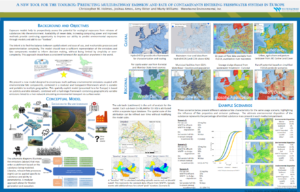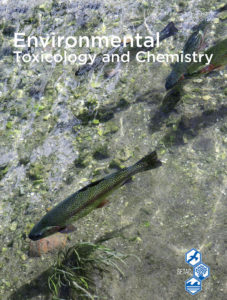2018
Holmes, C.M. (Waterborne Environmental, Inc); Amos, J. (Waterborne Environmental, Inc); Ritter, A. (Waterborne Environmental, Inc); Williams, M. (Waterborne Environmental, Inc)
11.04.2018.
Links | Tags: 2018, Poster, SETAC North America
@misc{2018Toolbox,
title = {A New Tool for the Toolbox: Predicting Multi-Pathway Emission and Fate of Contaminants Entering Freshwater Systems in Europe},
author = {Holmes, C.M. (Waterborne Environmental, Inc) and Amos, J. (Waterborne Environmental, Inc) and Ritter, A. (Waterborne Environmental, Inc) and Williams, M. (Waterborne Environmental, Inc)},
url = {https://appliedanalysis.solutions/wp-content/uploads/2021/01/SETAC_NA_2018_Multipathway.pdf, View poster
https://www.waterborne-env.com/wp-content/uploads/MP068_Holmes_Multipathway_final.pdf, Poster originally available from Waterborne Environmental},
year = {2018},
date = {2018-11-04},
urldate = {2018-11-04},
organization = {SETAC North America},
keywords = {2018, Poster, SETAC North America},
pubstate = {published},
tppubtype = {presentation}
}
Holmes, C.M. (Waterborne Environmental, Inc); Brown, C.D. (University of York); Hamer, M. (Syngenta); Jones, R. (Bayer CropScience); Maltby, L. (The University of Sheffield); Posthuma, L. (National Institute for Public Health & the Environment (RIVM)); Silberhorn, E. (US Food & Drug Administration); Teeter, J.S. (Elanco Animal Health); Warne, M.S.J. (Coventry University); Weltje, L. (BASF)
Prospective Aquatic Risk Assessment for Chemical Mixtures in Agricultural Landscapes Journal Article
In: Environmental Toxicology & Chemistry, vol. 37, no. 3, pp. 674-689, 2018.
Abstract | Links | Tags: 2018, Peer-Reviewed Publication
@article{2017ProAqu,
title = {Prospective Aquatic Risk Assessment for Chemical Mixtures in Agricultural Landscapes},
author = {Holmes, C.M. (Waterborne Environmental, Inc) and Brown, C.D. (University of York) and Hamer, M. (Syngenta) and Jones, R. (Bayer CropScience) and Maltby, L. (The University of Sheffield) and Posthuma, L. (National Institute for Public Health & the Environment (RIVM)) and Silberhorn, E. (US Food & Drug Administration) and Teeter, J.S. (Elanco Animal Health) and Warne, M.S.J. (Coventry University) and Weltje, L. (BASF)},
url = {https://setac.onlinelibrary.wiley.com/doi/10.1002/etc.4049, Online publication
https://appliedanalysis.solutions/wp-content/uploads/2021/10/Prospective-aquatic-risk-assessment-for-chemical-mixtures-in-agricultural-landscapes.pdf, View document},
doi = {https://doi.org/10.1002/etc.4049},
year = {2018},
date = {2018-03-01},
urldate = {2018-03-01},
journal = {Environmental Toxicology & Chemistry},
volume = {37},
number = {3},
pages = {674-689},
abstract = {Environmental risk assessment of chemical mixtures is challenging because of the multitude of possible combinations that may occur. Aquatic risk from chemical mixtures in an agricultural landscape was evaluated prospectively in 2 exposure scenario case studies: at field scale for a program of 13 plant-protection products applied annually for 20 yr and at a watershed scale for a mixed land-use scenario over 30 yr with 12 plant-protection products and 2 veterinary pharmaceuticals used for beef cattle. Risk quotients were calculated from regulatory exposure models with typical real-world use patterns and regulatory acceptable concentrations for individual chemicals. The results could differentiate situations when there was concern associated with single chemicals from those when concern was associated with a mixture (based on concentration addition) with no single chemical triggering concern. Potential mixture risk was identified on 0.02 to 7.07% of the total days modeled, depending on the scenario, the taxa, and whether considering acute or chronic risk. Taxa at risk were influenced by receiving water body characteristics along with chemical use profiles and associated properties. The present study demonstrates that a scenario-based approach can be used to determine whether mixtures of chemicals pose risks over and above any identified using existing approaches for single chemicals, how often and to what magnitude, and ultimately which mixtures (and dominant chemicals) cause greatest concern. Environ Toxicol Chem 2018;37:674–689. © 2017 The Authors. Environmental Toxicology and Chemistry published by Wiley Periodicals, Inc. on behalf of SETAC. },
keywords = {2018, Peer-Reviewed Publication},
pubstate = {published},
tppubtype = {article}
}
Posthuma, L. (National Institute for Public Health & the Environment (RIVM)); Brown, C.D. (University of York); de Zwart, D. (Mermayde); Diamond, J. (Tetra Tech); Dyer, S. (The Procter & Gamble Company); Holmes, C.M. (Waterborne Environmental, Inc); Marshall, S. (Safety & Environmental Assurance Centre, Unilever); Burton Jr., G.A. (University of Michigan)
Prospective Mixture Risk Assessment and Management Prioritizations for River Catchments with Diverse Land Uses Journal Article
In: Environmental Toxicology & Chemistry, vol. 37, no. 3, pp. 715-728, 2018.
Abstract | Links | Tags: 2018, Peer-Reviewed Publication
@article{2017ProMix,
title = {Prospective Mixture Risk Assessment and Management Prioritizations for River Catchments with Diverse Land Uses},
author = {Posthuma, L. (National Institute for Public Health & the Environment (RIVM)) and Brown, C.D. (University of York) and de Zwart, D. (Mermayde) and Diamond, J. (Tetra Tech) and Dyer, S. (The Procter & Gamble Company) and Holmes, C.M. (Waterborne Environmental, Inc) and Marshall, S. (Safety & Environmental Assurance Centre, Unilever) and Burton Jr., G.A. (University of Michigan)},
url = {https://setac.onlinelibrary.wiley.com/doi/10.1002/etc.3960, View Online
https://appliedanalysis.solutions/wp-content/uploads/2020/01/Posthuma_et_al-2018-ETC_Prospective-Mixture-Risk-Assessment-Catchments-with-Diverse-Land-Uses.pdf, View document},
doi = {https://doi.org/10.1002/etc.3960},
year = {2018},
date = {2018-03-01},
urldate = {2018-03-01},
journal = {Environmental Toxicology & Chemistry},
volume = {37},
number = {3},
pages = {715-728},
abstract = {Ecological risk assessment increasingly focuses on risks from chemical mixtures and multiple stressors because ecosystems are commonly exposed to a plethora of contaminants and nonchemical stressors. To simplify the task of assessing potential mixture effects, we explored 3 land use–related chemical emission scenarios. We applied a tiered methodology to judge the implications of the emissions of chemicals from agricultural practices, domestic discharges, and urban runoff in a quantitative model. The results showed land use–dependent mixture exposures, clearly discriminating downstream effects of land uses, with unique chemical “signatures” regarding composition, concentration, and temporal patterns. Associated risks were characterized in relation to the land-use scenarios. Comparisons to measured environmental concentrations and predicted impacts showed relatively good similarity. The results suggest that the land uses imply exceedances of regulatory protective environmental quality standards, varying over time in relation to rain events and associated flow and dilution variation. Higher-tier analyses using ecotoxicological effect criteria confirmed that species assemblages may be affected by exposures exceeding no-effect levels and that mixture exposure could be associated with predicted species loss under certain situations. The model outcomes can inform various types of prioritization to support risk management, including a ranking across land uses as a whole, a ranking on characteristics of exposure times and frequencies, and various rankings of the relative role of individual chemicals. Though all results are based on in silico assessments, the prospective land use–based approach applied in the present study yields useful insights for simplifying and assessing potential ecological risks of chemical mixtures and can therefore be useful for catchment-management decisions. Environ Toxicol Chem 2018;37:715–728. © 2017 The Authors. Environmental Toxicology Chemistry Published by Wiley Periodicals, Inc. },
keywords = {2018, Peer-Reviewed Publication},
pubstate = {published},
tppubtype = {article}
}
Posthuma, L. (National Institute for Public Health & the Environment (RIVM)); Brown, C.D. (University of York); de Zwart, D. (Mermayde); Diamond, J. (Tetra Tech); Dyer, S. (The Procter & Gamble Company); Hamer, M. (Syngenta); Holmes, C.M. (Waterborne Environmental, Inc); Marshall, S. (Safety & Environmental Assurance Centre, Unilever); Burton Jr., G.A. (University of Michigan)
Simplifying Environmental Mixtures—An Aquatic Exposure-Based Approach Via Land Use Scenarios Journal Article
In: Environmental Toxicology & Chemistry, vol. 37, no. 3, pp. 671-673, 2018.
Abstract | Links | Tags: 2018, Peer-Reviewed Publication
@article{2018SimpEnv,
title = {Simplifying Environmental Mixtures—An Aquatic Exposure-Based Approach Via Land Use Scenarios},
author = {Posthuma, L. (National Institute for Public Health & the Environment (RIVM)) and Brown, C.D. (University of York) and de Zwart, D. (Mermayde) and Diamond, J. (Tetra Tech) and Dyer, S. (The Procter & Gamble Company) and Hamer, M. (Syngenta) and Holmes, C.M. (Waterborne Environmental, Inc) and Marshall, S. (Safety & Environmental Assurance Centre, Unilever) and Burton Jr., G.A. (University of Michigan)},
url = {https://setac.onlinelibrary.wiley.com/doi/10.1002/etc.4063, View Online
https://appliedanalysis.solutions/wp-content/uploads/2020/01/Posthuma_et_al-2018-ETC_Simplifying-Environmental-Mixtures.pdf, View document},
doi = {https://doi.org/10.1002/etc.4063},
year = {2018},
date = {2018-02-26},
urldate = {2018-02-26},
journal = {Environmental Toxicology & Chemistry},
volume = {37},
number = {3},
pages = {671-673},
abstract = {No abstract is available for this article},
keywords = {2018, Peer-Reviewed Publication},
pubstate = {published},
tppubtype = {article}
}


